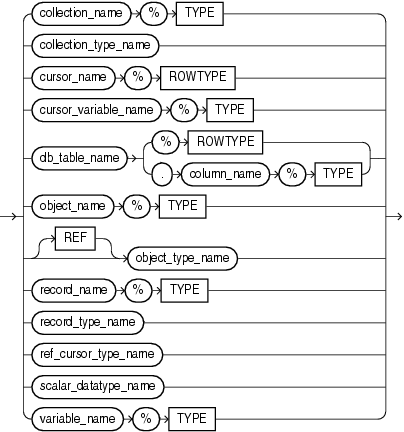| Oracle® Database PL/SQL User's Guide and Reference 10g Release 2 (10.2) Part Number B14261-01 |
|
|
PDF · Mobi · ePub |
| Oracle® Database PL/SQL User's Guide and Reference 10g Release 2 (10.2) Part Number B14261-01 |
|
|
PDF · Mobi · ePub |
You can declare constants and variables in the declarative part of any PL/SQL block, subprogram, or package. Declarations allocate storage for a value, specify its datatype, and specify a name that you can reference. Declarations can also assign an initial value and impose the NOT NULL constraint. For more information, see Declarations.
variable declaration ::=

datatype ::=

constant ::=

Keyword and Parameter Description
collection_name
A collection (associative array, nested table, or varray) previously declared within the current scope.
collection_type_name
A user-defined collection type defined using the datatype specifier TABLE or VARRAY.
Denotes the declaration of a constant. You must initialize a constant in its declaration. Once initialized, the value of a constant cannot be changed.
constant_name
A program constant. For naming conventions, see "Identifiers".
cursor_name
An explicit cursor previously declared within the current scope.
cursor_variable_name
A PL/SQL cursor variable previously declared within the current scope.
db_table_name
A database table or view that must be accessible when the declaration is elaborated.
db_table_name.column_name
A database table and column that must be accessible when the declaration is elaborated.
expression
A combination of variables, constants, literals, operators, and function calls. The simplest expression consists of a single variable. When the declaration is elaborated, the value of expression is assigned to the constant or variable. The value and the constant or variable must have compatible datatypes.
A constraint that prevents the program from assigning a null value to a variable or constant. Assigning a null to a variable defined as NOT NULL raises the predefined exception VALUE_ERROR. The constraint NOT NULL must be followed by an initialization clause.
object_name
An instance of an object type previously declared within the current scope.
record_name
A user-defined or %ROWTYPE record previously declared within the current scope.
record_name.field_name
A field in a user-defined or %ROWTYPE record previously declared within the current scope.
record_type_name
A user-defined record type that is defined using the datatype specifier RECORD.
ref_cursor_type_name
A user-defined cursor variable type, defined using the datatype specifier REF CURSOR.
%ROWTYPE
Represents a record that can hold a row from a database table or a cursor. Fields in the record have the same names and datatypes as columns in the row.
scalar_datatype_name
A predefined scalar datatype such as BOOLEAN, NUMBER, or VARCHAR2. Includes any qualifiers for size, precision, or character versus byte semantics.
%TYPE
Represents the datatype of a previously declared collection, cursor variable, field, object, record, database column, or variable.
variable_name
A program variable.
Constants and variables are initialized every time a block or subprogram is entered. By default, variables are initialized to NULL. Whether public or private, constants and variables declared in a package spec are initialized only once for each session.
An initialization clause is required when declaring NOT NULL variables and when declaring constants. If you use %ROWTYPE to declare a variable, initialization is not allowed.
You can define constants of complex types that have no literal values or predefined constructors, by calling a function that returns a filled-in value. For example, you can make a constant associative array this way.
For examples, see the following: